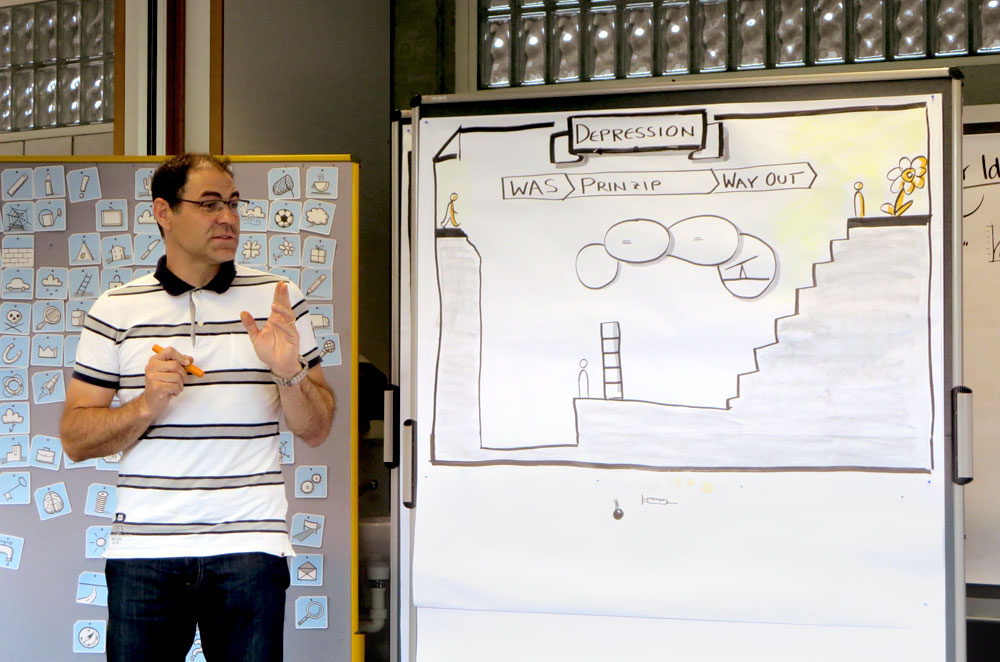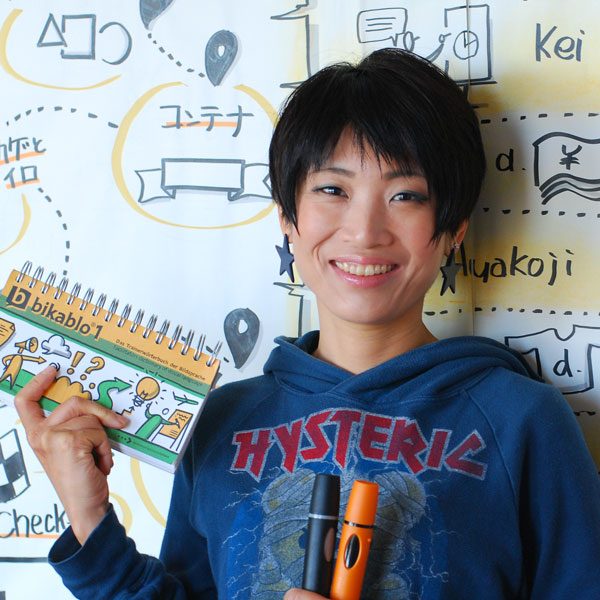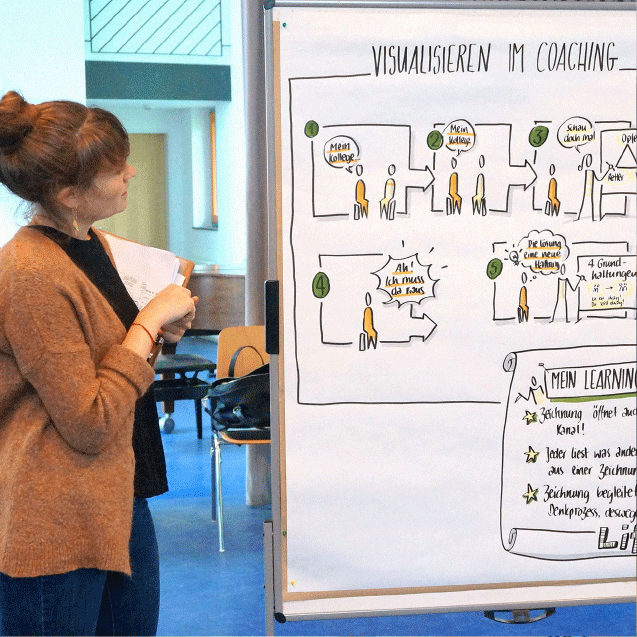Using Visualization in Your Career – Something Everyone Can Do!
Visualization can be integrated into everyday work life in a wide variety of ways. Most often, this is done to help make technical information understandable during presentations or to document conversations or to explore problems. At a recent training session in Switzerland, I saw an excellent example of how to put visualization to use during a presentation.
by Martin Haussmann
SHARE ARTICLE
A medical doctor explains “unmentionables” with a pencil
At the conclusion of a bikablo basic training, participants design presentations on a topic of their own choosing. Lukas, a physician from Hinwil, Switzerland, used a poster to explain to us the origins of depression and how it can be treated. The group loved his simple illustrations, which came across as empathetic and yet somehow still joyful. We had never experienced such an informative presentation on such a difficult and often taboo subject. Lukas still continues to use visualization with patients who show indications of depression. He told me that visualization makes it easier for him to engage his patients in discussion so that he can help provide them with the best medical care and/or counseling.

Design: Visualization – It’s Not Just for “Creative Types!”
As you can see, designers, artists, and illustrators aren’t the only people who can effectively work with visualization – even if it does seem, at first, that people in those professions have a leg up on the rest of us: designers do often possess a good intuitive sense for translating abstract concepts into images. But, even they can learn from a bikablo training session – how to optimize their drawing technique, to draw faster, to develop a targeted repertoire of visual vocabulary, and to learn combination strategies for creating visuals.
In reality, people from many other professions also reap the enormous benefits of learning visualization, even when, at first glance, they don’t appear to be “creative types.” Especially for people – as with our physician – who have to deal with difficult subject matter, visualization can be put to use in a meaningful way. Other experts, including anyone who needs to make detailed information and its inherent interrelationships accessible to others, can also benefit from learning and using visualization.
Content: Visual Storytelling – Getting to the Heart of the Matter
Take the engineering profession as an example: engineers can use visualization in their work to help simplify complex concepts or to make clear the individual steps in a process. They help colleagues, co-workers, and service providers to comprehend the technical information that is essential to their interdisciplinary collaboration.
For the same reason, visualization can be an exciting tool for knowledge workers, educators, journalists, copywriters, and many other professionals. Like engineers, these people come more from the “content” side than the “design” side – for these experts, the focus of their work is on specialized topics. Visualization allows them to initiate an exchange with other collaborators or to learn techniques to help them in their studies or to pursue careers as educators.
Context: Visual Facilitation – Helping Support Team and Organizational Processes
The work done by moderators, facilitators, coaches, and consultants is generally “context-related.” It’s frequently less about providing information than it is about providing support for learning, transformation, and team processes. The challenge they face is to facilitate discussions that center on sensitive topics. In these situations, images can function as catalysts for ideas that encourage dialogue, lend dignity to the participants, allow the unspoken to be brought into the conversation, reveal differing perspectives, and pin down agreements. This technique is referred to as Visual Facilitation – it is the highest order of visual thinking, learning, and collaboration. The best-known role in this area is that of the Graphic Recorder.
How to Become a Visualizer
Could visualization, visual storytelling, or visual facilitation be beneficial in your career? Grab a pen and find out! Our bikablo visualization training can help you build these skills.
MORE ARTICLES ON THIS TOPIC
You Might Also Be Interested In...

How to use your iPad instead of the webcam in MS Teams
Why do I want to connect the iPad to MS Teams (or Zoom)?
I would like to be able to show my iPad Screen as a tile in the normal Teams window. It should be subtle and not by sharing my screen to draw to much attention and to have a seamless switch between different views. I can i.e.
• document the meeting using OneNote or ProCreate
• easily zoom into pictures or drawing
• easily annotate pictures or digital whiteboards
• using the drawing feature while presenting your content

Design Thinking and Visual Thinking – a perfect fit?
In a recent interview Hiromi Hara speaks about her experience with applying the design thinking method with the help of visualization.
Hara explains that design thinking is not primarily about problem solving, rather about unveiling complex problems and getting better insight in the root cause of issues, hence the importance of the expression of individual perception and the comprehensible yet memorable depiction of thinking processes.

Using Visuals in Coaching
How our global trainer Jill Greenbaum got into drawing and which impact visualization has got on coaching situations.